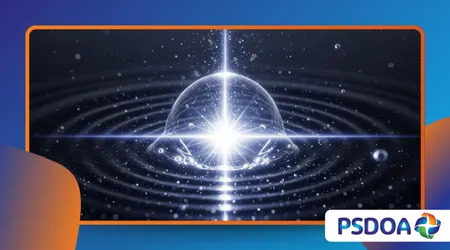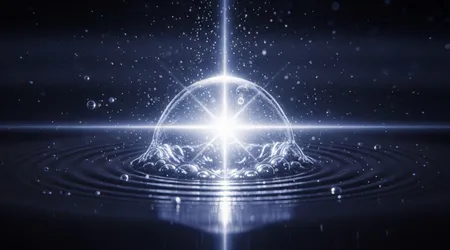The Mystery of Sonoluminescence: When Sound Creates Light

The Mystery of Sonoluminescence remains one of the most mesmerizing and perplexing phenomena in modern physics, a strange alchemy where concentrated sound waves produce fleeting, intense flashes of light in a liquid.
Anúncios
This is not science fiction; it is the radical power of acoustic energy harnessed at the micro-scale. Imagine the gentle hum of an ultrasound transducer creating conditions hotter than the surface of the sun that is the captivating paradox at the heart of this research.
This phenomenon, first observed in the 1930s, involves a small, trapped gas bubble in a liquid (often water or sulfuric acid) driven by a standing acoustic wave.
The bubble violently expands and, more critically, collapses, compressing the gas within to extreme densities and temperatures.
Researchers worldwide are studying this unique energy concentration, seeking to unlock its powerful, and potentially world-changing, applications.
Anúncios
We are now in 2025, and the pursuit of understanding The Mystery of Sonoluminescence has never been more intense.
What Exactly Is Sonoluminescence and How Does It Work?
Sonoluminescence is essentially the emission of short bursts of light from imploding bubbles in a liquid subjected to sound waves. The process centers entirely on the nonlinear dynamics of a cavitation bubble.
How Does Acoustic Energy Concentrate into Light?
The magic begins with a standing wave of sound, typically in the ultrasonic range, which creates an acoustic pressure field. This field traps a tiny gas bubble, perhaps 50 micrometers in diameter, holding it at a stable point.
During the negative (rarefaction) phase of the sound wave, the bubble expands dramatically, potentially reaching ten times its original size. Then, the positive (compression) phase violently compresses the bubble back inward.
This inward collapse is so swift it takes mere nanoseconds that the gas inside cannot dissipate the heat fast enough.
This extreme, adiabatic compression generates temperatures and pressures inside the bubble core that defy normal expectations, leading to a flash of light.
++ The Bizarre Physics of Time Crystals
What Physical Conditions Are Achieved Inside the Collapsing Bubble?
The temperatures generated within the bubble core are what make The Mystery of Sonoluminescence so significant.
Spectroscopic measurements have indicated plasma temperatures ranging from 2,300 K to over 5,100 K in water, which is incredibly hot.
However, complex hydrodynamic simulations and some theoretical models suggest peak temperatures could potentially reach tens of thousands of Kelvin, hotter than the surface of the Sun (around 5,778 K).
The sheer violence of the collapse is what concentrates the diffuse acoustic energy into a point of blinding light and heat.
Researchers at NASA Glenn Research Center, investigating the phenomenon for energy purposes, noted evidence of high-energy generation in sonoluminescence experiments using heavy water, providing strong, continuous data for analysis.
The extreme conditions created briefly mimic the environments found in thermonuclear fusion experiments, albeit on a far smaller, controlled scale.

Why Are Sonoluminescence Temperatures a Source of Scientific Debate?
The exact peak temperature of the collapsing bubble remains one of the central arguments in this field, pitting experimental evidence against theoretical models.
This disagreement fuels much of the current research into The Mystery of Sonoluminescence.
Also read: Rare asteroid impact fragments in Australia
What Measurement Techniques Reveal the Internal Conditions?
Scientists use ultrafast spectroscopy, analyzing the spectrum of the emitted light to infer the internal temperature. The light is broadband, meaning it has no distinct lines, making temperature estimation challenging.
Some measurements detect light emissions from excited radicals, like , which suggests temperatures in the thousands of Kelvin. Other methods rely on noble gas excitation within the bubble, pushing estimates higher.
The intense debate revolves around the short duration of the flash, which lasts only picoseconds, making precise measurement incredibly difficult. Is the measured temperature the average of a plasma or a low-end reflection of a super-hot core?
Read more: Strange exoplanets with bizarre atmospheres
Does the Bubble’s Asymmetry Limit the Maximum Temperature?
The theoretical maximum temperature relies on the bubble maintaining a perfectly spherical collapse a state known as spherical symmetry. Any deviation, or asymmetry, allows energy to leak away in the form of liquid jets.
In practical laboratory settings, slight imperfections in the acoustic field or fluid impurities can cause the bubble to deform, preventing the absolute maximum energy concentration.
This fluid dynamics problem imposes a practical limit on observed temperatures.
This mechanical constraint means that while models predict fusion-level temperatures, the reality of a slightly imperfect collapse means the bubble might only reach the lower but still extreme range of to
. Can we truly achieve a perfectly symmetrical implosion?
What Are the Most Promising Applications of Sonoluminescence Research?
Beyond the fundamental physics, the ability to concentrate energy so dramatically offers tantalizing real-world applications across multiple scientific disciplines.
Harnessing The Mystery of Sonoluminescence could revolutionize areas like chemistry and medicine.
How is Sonoluminescence Used in Sonochemistry?
The intense temperature and pressure waves created by the bubble collapse induce chemical reactions in the surrounding liquid a process known as sonochemistry. This is the practical application of the energy released.
These radicals can drive reactions that are impossible or impractical under normal conditions.
A pharmaceutical company could use sonochemistry to accelerate the synthesis of complex organic molecules, performing reactions faster and requiring less solvent and catalyst, leading to a more efficient and ‘green’ production process.
Is “Bubble Fusion” a Viable Energy Source?
The most controversial, yet potentially transformative, application is the long-debated idea of sonofusion, or “bubble fusion.”
This hypothesizes that the extreme temperatures might be sufficient to force deuterium atoms (heavy hydrogen) inside the bubble to fuse, releasing clean, abundant energy.
In one highly debated 2002 experiment using deuterated acetone, researchers claimed to have detected neutron and tritium production consistent with fusion.
While highly scrutinized and difficult to replicate consistently, this line of research is critical.
If large-scale magnetic confinement fusion (like the project) is a colossal, high-tech hammer seeking to smash atoms together, sonoluminescence is a microscopic, ultra-precise needle, using sound to puncture the nuclei. It is a quest for controlled micro-fusion events.
How Can Sonoluminescence Revolutionize Materials Science?
The energy from sonoluminescence can generate extreme localized pressures, which scientists are using to manipulate matter. This can lead to the formation of unique nanoparticles or new metastable materials.
The sudden, intense shockwave from the collapse can also alter the surface properties of materials submerged in the liquid.
This can be exploited for industrial cleaning, enhancing catalytic surfaces, or even developing novel coatings.
Comparative Dynamics: Sonoluminescence vs. Traditional Fusion
Understanding the differences between sonoluminescence-induced plasma and conventional fusion plasma is vital for evaluating its energy potential. They operate on entirely different scales and mechanisms.
| Characteristic | Single-Bubble Sonoluminescence (SBSL) | Conventional Tokamak Fusion (e.g., |
| Peak Temperature (Estimated) | ||
| Plasma Density | Very High ( | Extremely High ( |
| Duration of Event | Picoseconds (Light Flash) | Seconds to Minutes (Sustained Confinement) |
| Mechanism | Adiabatic, Spherical Shockwave Implosion | Magnetic Confinement of Super-Hot Plasma |
Research published in Physical Review Letters in 2014 demonstrated that the plasma density achieved in sonoluminescing bubbles is almost as dense as that targeted in inertial confinement fusion (ICF) research, reaching .
Biomedical researchers are exploring the use of sonoluminescence as a highly localized light source within the body.
Micro-bubbles injected near a tumor could be activated by external ultrasound, causing them to emit light in situ to activate photosensitive cancer drugs (photodynamic therapy), thereby precisely targeting malignant cells.
Conclusion: The Unfolding Light in the Darkness
The Mystery of Sonoluminescence continues to challenge our understanding of how energy can be focused and released.
This small, silent flash of light represents an enormous concentration of power, a microcosm of cosmic events created with just a little sound.
Whether it ultimately delivers a clean energy breakthrough or simply revolutionizes specialized chemistry, the future of this research is undeniably bright.
The study of this phenomenon pushes the boundaries of plasma physics, acoustics, and quantum mechanics simultaneously. Are we truly just scratching the surface of sonoluminescence’s potential?
We must continue to fund and encourage this unconventional exploration. Share your thoughts on the potential of bubble fusion in the comments below.
Frequently Asked Questions (FAQ)
Does happen in nature?
Yes, a natural form of multibubble sonoluminescence occurs in the cavitation bubbles created by the snapping claws of the pistol shrimp.
These bubbles collapse with such force they produce a sonic shockwave, a momentary flash of light, and a high-speed jet of water, used to stun prey.
Why do different liquids produce different sonoluminescence results?
The surrounding liquid’s properties are critical. Liquids with a low vapor pressure, such as sulfuric acid, result in a hotter, brighter flash because less non-condensable vapor is trapped inside the bubble to cushion the collapse.
What is the main theory that competes with the high-temperature explanation?
The “vacuum energy” or “dynamic Casimir effect” theory suggests the light is emitted not from extreme heat, but from the conversion of virtual photons into real photons due to the lightning-fast movement of the bubble wall, which acts as a moving mirror.
However, most observed spectral data leans toward the thermal/plasma explanation.
